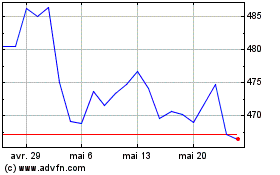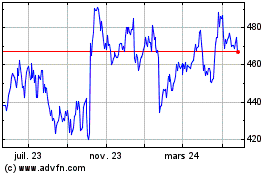NASA Expected to Further Delay Its James Webb Space Telescope
27 Mars 2018 - 3:33PM
Dow Jones News
By Andy Pasztor
NASA on Tuesday is expected to announce a delay of several
months or longer for the James Webb Space Telescope, the agency's
premier space-science program that has been beset by schedule slips
and cost overruns, according to people familiar with the
details.
The latest setback, these people said, reflects the need for
additional testing, verification and integration checks of the
multibillion dollar project extending beyond the previously
announced June 2019 launch date.
The new deadline is anticipated to be no earlier than late 2019.
National Aeronautics and Space Administration officials and senior
managers at Northrop Grumman Corp., prime contractor for part of
the space telescope, have discussed a delay potentially stretching
even into the first quarter of 2020, according to one of these
people.
Such a move is bound to boost the program's total cost above the
$8.8 billon limit previously established by lawmakers, but the
probable size of the increase has been closely held by managers and
isn't clear. Congress must be notified of any schedule or cost
changes.
NASA has called a media briefing for Tuesday with outgoing
acting administrator Robert Lightfoot and two other high-ranking
agency officials to provide an update.
The high-profile program is the largest international scientific
effort in U.S. history that doesn't involve astronauts, and it is
the most advanced space telescope ever developed.
A NASA spokesman didn't have an immediate comment. A Northrop
Grumman spokesman said the company "remains steadfast in its
commitment to NASA and ensuring successful integration, launch and
deployment," but declined to elaborate.
Tuesday's developments, however, follow a U.S. Government
Accountability Office report last month projecting likely schedule
and cost slippage. That study concluded, among other things, that
NASA had a history of overstating workforce reductions; that
management decisions had eroded much of the program's funding
cushions; and that the agency still confronted stiff technical
challenges. At the time, the GAO also said certain "work continues
to take longer than planned."
GAO auditors found that project managers had "used all remaining
schedule reserve -- or extra time set aside in the schedule in the
event of delays or unforeseen risks -- to address technical
issues," including problems detected during vibration testing.
Initially, the project carried a price tag of around $1.6
billion and was supposed to begin operation in 2011
Last year, NASA pushed scheduled blastoff of the massive
telescope from October 2018 to a launch window between March and
June 2019, primarily as a result of delays integrating
components.
Months before, NASA administrator Charles Bolden told reporters
the space telescope was "an incredibly difficult program to
manage." He said "it almost didn't happen" due to a cascade of
previous problems.
Just two weeks ago, NASA issued an upbeat statement indicating
work was progressing well and that the agency had experienced
"great success" in demonstrating readiness for launch.
But during a NASA advisory committee meeting last week, the
agency telegraphed further delays were anticipated in the wake of
an independent schedule review.
As part of the fiscal 2018 omnibus spending bill that lawmakers
passed last week, the program received the full $533.7 million
requested by the White House. But as in past spending packages,
Congress directed NASA to notify it of any cost increase.
Slated for launch by a European Ariane rocket, the telescope is
the most sophisticated -- and expensive -- space observatory ever
conceived, featuring a 21.3-foot-wide primary mirror made up of 18
adjustable gold-coated segments. The design, much larger than its
predecessor Hubble Space Telescope, is intended to capture infrared
light behind a complex sunshade that unfurls to the size of a
tennis court. NASA aims to use the next-generation platform to find
new planets and cosmic structures and to better understand
formation of distant stars, galaxies and the universe itself.
Unlike Hubble, which operated in orbit relatively close to the
earth and was able to be repeatedly repaired and serviced by
astronauts, the James Webb telescope is bound for a location some
one million miles away. It won't be accessible to any astronauts,
which accounts for the extensive testing regime. Its mirrors have
to be precisely polished and formed so they will achieve and
maintain the correct shape in the frigid space environment.
Write to Andy Pasztor at andy.pasztor@wsj.com
(END) Dow Jones Newswires
March 27, 2018 09:18 ET (13:18 GMT)
Copyright (c) 2018 Dow Jones & Company, Inc.
Northrop Grumman (NYSE:NOC)
Graphique Historique de l'Action
De Juin 2024 à Juil 2024

Northrop Grumman (NYSE:NOC)
Graphique Historique de l'Action
De Juil 2023 à Juil 2024
